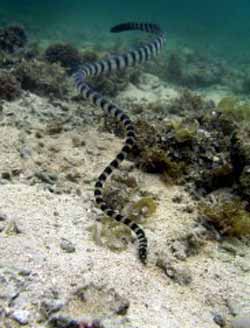Scientists Discover Reasons Behind Snakes’ ‘Shrinking Heads’

<br>
Their research is published today in the journal Molecular Ecology (doi: 10.1111/mec.12291).
A large head – “all the better to eat you with” – would seem to be indispensable to sea snakes, which typically have to swallow large spiny fish. However, there are some circumstances where it wouldn’t be very useful: sea snakes that feed by probing their front ends into narrow, sand eel burrows have evolved comically small heads.
The team has shown normal-shaped sea snakes can evolve such “shrunken heads” very rapidly. This process can rapidly lead to speciation (one species splitting into two).
The small-headed populations are also much smaller in absolute size than their ancestors, and these shape and size differences mean they tend to avoid interbreeding with their large-headed ancestors.
Dr Lee says, “A team led by my colleague Dr Kate Sanders at the University of Adelaide has been investigating genetic differences across all sea snakes, and we noticed that the blue-banded sea snake (Hydrophis cyanocinctus) and the slender-necked sea snake (Hydrophis melanocephalus) were almost indistinguishable genetically, despite being drastically different in size and shape.
“The slender-necked sea snake is half the size, and has a much smaller head, than the blue-banded sea snake.
“This suggested they separated very recently from a common ancestral species and had rapidly evolved their different appearances. One way this could have happened is if the ancestral species was large-headed, and a population rapidly evolved small heads to probe eel burrows – and subsequently stopped interbreeding with the large-headed forms.”
Dr Sanders says the research could have wider implications in other scientific studies: “Our results highlight the viviparous sea snakes as a promising system for studies of speciation and adaptive radiation in marine environments.”
Caption: A small-headed sea snake foraging in waters off the Ryuku Islands. Photo by Yoshitaka Tahara
Dr Michael Lee, Associate Professor
South Australian Museum and University of Adelaide
Mike.Lee@samuseum.sa.gov.au or Michael.S.Lee@adelaide.edu.au
Phone + 61 8 8207 7568)
Media Contact
More Information:
http://www.adelaide.edu.auAll latest news from the category: Life Sciences and Chemistry
Articles and reports from the Life Sciences and chemistry area deal with applied and basic research into modern biology, chemistry and human medicine.
Valuable information can be found on a range of life sciences fields including bacteriology, biochemistry, bionics, bioinformatics, biophysics, biotechnology, genetics, geobotany, human biology, marine biology, microbiology, molecular biology, cellular biology, zoology, bioinorganic chemistry, microchemistry and environmental chemistry.
Newest articles

Bringing bio-inspired robots to life
Nebraska researcher Eric Markvicka gets NSF CAREER Award to pursue manufacture of novel materials for soft robotics and stretchable electronics. Engineers are increasingly eager to develop robots that mimic the…

Bella moths use poison to attract mates
Scientists are closer to finding out how. Pyrrolizidine alkaloids are as bitter and toxic as they are hard to pronounce. They’re produced by several different types of plants and are…

AI tool creates ‘synthetic’ images of cells
…for enhanced microscopy analysis. Observing individual cells through microscopes can reveal a range of important cell biological phenomena that frequently play a role in human diseases, but the process of…





















